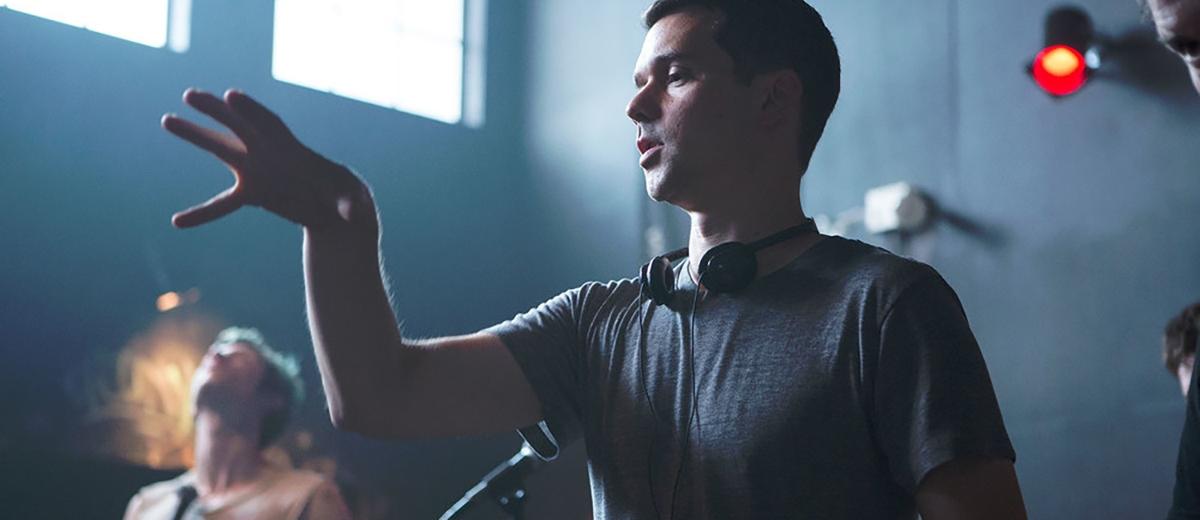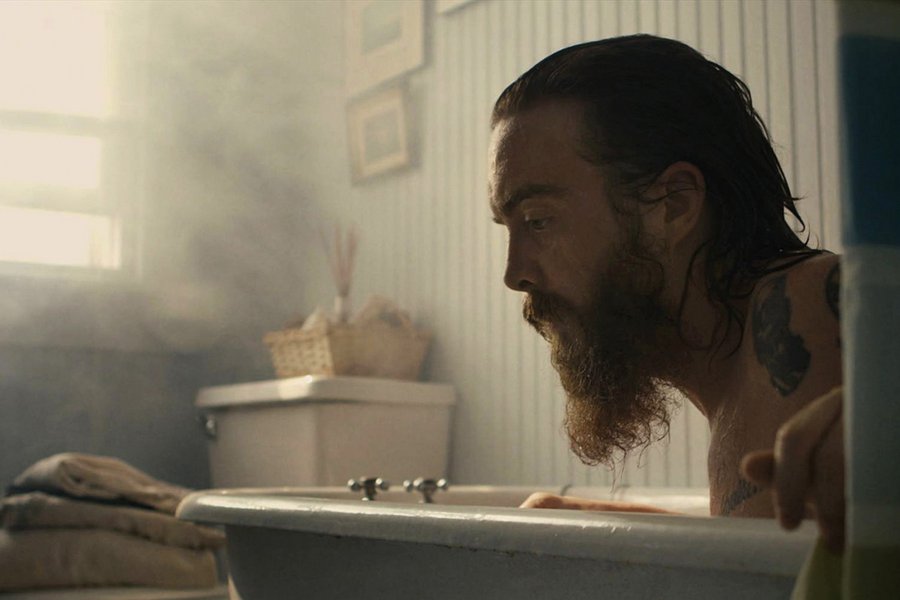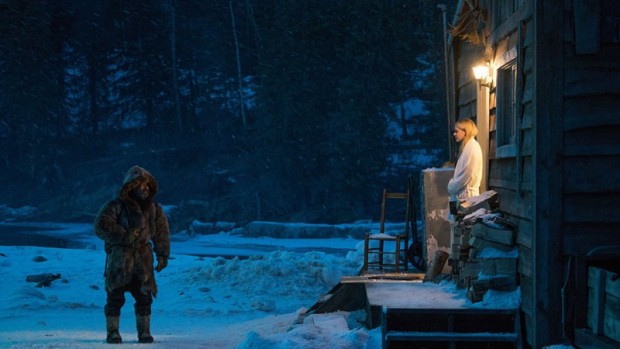
After his breakout film Blue Ruin—which he made for a minuscule $420,000—premiered to rave reviews at the 2013 Cannes Film Festival Director’s Fortnight, Jeremy Saulnier has released three more critically beloved and admired pieces: Green Room, Hold the Dark, and the first two episodes True Detective season three. Each of these four works are masterclasses in genre filmmaking and provide wonderfully specific “craft lessons” that creatives at all levels should take note of.
Diving right in. . . .
Blue Ruin is a wonderfully sparse, emotionally resonant, and excruciatingly (in the best possible way) tense thriller that follows Dwight, a soft-spoken, haunted homeless man. After learning the man who murdered his parents will soon be released from prison, Dwight is sent down the path of vengeance with increasingly brutal consequences for him and all those in his orbit.
Here’s the thing about Blue Ruin: in no way is this concept an original one. We’ve seen the “man seeking revenge on a murderer” trope a million times before.
So what makes it absolutely sparkle? Flawless execution.
Let’s start with the character development. You know how you hear the phrase “show rather than tell?” This film is the poster child for that. Moreover, there is barely any dialogue throughout the entire film. Dwight in particular hardly says anything. Yet we know so much about him—his motivations, his “inner life” psychology, his background, etc. And why is that? Because Saulnier provides clues to this through Dwight’s actions. What he does carries so much more weight than what he says.
The opening scene, for instance, we see Dwight drawing himself a bath. He is seemingly very fussy about the temperature of it, turning the knobs on and off several times. Just as he finally gets comfortable, he hears a car pulling up outside. As he, with lightning speed, bursts out the bathroom window and flees, we realize that this is not his house—that he was turning the knobs on and off so frequently to keep himself alert to the homeowners’ arrival.
This is insanely well-done, quick-hit character writing. In this scene, we learn that Dwight is a capable vagrant, highly crafty and intelligent, and someone who, instead of electing to steal someone’s valuables, only breaks into a home for the simple, basic human pleasure of a hot bath. A less confident/skilled filmmaker would have needed much longer and a mountain of dialogue to get these traits across, and Saulnier did it in 90 seconds. With no words spoken.

Macon Blair in “Blue Ruin”
Blue Ruin shines in its tension-building. Throughout the entire film, there is this undeniable feeling of palpable dread coursing through the veins of every single scene, even in the more mundane ones. At no point do the stakes drag or stall out. Each plot point always builds upon the next with heightened consequences. And while it’s vital to continually raise the stakes in all types of films, this need is doubled in genres like thriller and horror, which live and die on these heightened circumstances. Furthermore, through the simple action of denying Dwight what he wants at every turn (and thus inherently raising the stakes), Saulnier allows for the rich character work and terrifically brooding atmosphere he’s created to seep into every pore of Blue Ruin and present the beautifully textured piece of art we see on screen.
The takeaway? Less is more.
Blue Ruin is a prime example of not necessarily needing the fancy bells and whistles of filmmaking (such as a massive budget, huge set pieces, and tons of VFX/CGI) in order to make a movie sing—that if you have a command of the timeless fundamentals of storytelling and execute them with precision, plaudits will follow.
Saulnier’s Green Room chronicles a punk rock band forced to fight for their lives after witnessing a murder in an off-the-grid neo-Nazi skinhead bar. This is another sterling example of masterful tension-building, complete and utter command of the technical aspects of filmmaking, and visceral, bone-chilling, terrifying authenticity. Arguably his most popular and well-known film, Saulnier was given a much (comparatively, anyway) larger budget this time—around $5 million—and it shows in spades in its camerawork, production design, and suspenseful set pieces.
While not character-driven like Blue Ruin or his other titles, Green Room is a perfect tutorial for up-and-coming storytellers on how to assemble a movie where the “engine” is more the overall premise and circumstances as opposed to the characters.
In order to make this type of picture work, there are two things that absolutely must be in place: the concept must be fresh—something we haven’t quite seen before—and the pacing must never lag. The audience must be on the edge of their seats, engaged, and entertained the entire time. Luckily, Green Room excels in each.
With regards to its overall concept, Green Room takes a well-worn genre trope—a claustrophobic, (mostly) one location, fight-to-the-death suspense horror/thriller—and provides just enough of a twist to make it unique. Moreover, by rooting it in a neo-Nazi music bar, and having the main characters be punk rock musicians, Saulnier provides a take on the story immediately piquing interest. He’s not reinventing the wheel and doing an Inception-style idea that has never before been conceived, but he’s specializing it just enough for it to stand out. This is absolutely crucial for filmmakers who want to do more story-driven instead of character-centric content, especially in today’s saturated market. If it even remotely seems like something that’s too familiar, audiences may simply opt to watch something else.
Now, granted, even if you do everything just discussed in the previous paragraph and get the “butts in the seats,” you still have to deliver the goods. And that’s where Green Room positively sings.
Specifically, it moves at a breakneck, propulsive speed, never once slowing down to let the audience breathe. By choosing to be so quick and economical in the structure of the film’s storytelling, Saulnier magnifies the impact of the rapidly rising plight of the aforementioned bandmates a thousand fold. For instance, Green Room only spends 10minutes with the musicians before plunging them straight into the deep end of the neo-Nazi bar owned by Patrick Stewart’s terrifying skinhead character, Darcy.
This is a bold move by Saulnier, and one that pays off big. The pace of Green Room’s narrative—where before you can even process the horrible scene you’ve just watched, another even worse one hits you over the head with a sledgehammer—coupled with the anxiety-inducing action sequences, makes for an utterly immersive experience. There is one scene in particular (no spoilers) that involves ear-splitting microphone feedback blasting through the bar’s sound system, bloodthirsty German Shepherds, and copious amounts of gore and blood that is probably one of the best “cat and mouse” sequences I’ve ever seen.
Green Room is yet another notch in Saulnier’s belt, and will undoubtedly be studied and admired for years to come as a gripping genre film that subverted expectations of what an indie horror/thriller could—and should—be.
Hold the Dark, meanwhile, is a completely different animal (pun intended). Easily his most divisive and challenging film to date, it follows an expert wolf tracker who’s summoned to a remote Alaskan village to hunt down the pack of wolves that murdered a young child, but gets wrapped up in a deeper, darker, and even more haunting mystery in the process. It is a film that’s epic in its scope, relentlessly explores the murkiest crevices of the human condition, and is about as optimistic as a molotov cocktail and a shot of bourbon—easily one of the bleakest pieces of cinema ever made.
But it is glorious.

Jeffrey Wright and Riley Keough in “Hold the Dark”
Hold the Dark is one of those films that gets better and better upon multiple viewings. Led by a beautifully lyrical, poetic script by Macon Blair, Hold the Dark marks the first screenplay Saulnier did not write himself. The film, through a supremely stylized, surreal allegory, investigates the psychological effects of self-imposed isolation, the feral, savage nature of humankind, and the inherited fracture of familial trauma and absentee parenting. Saulnier’s visuals, which are (of course) haunting, visceral, and stupendous, are appropriately blunt and cold in their tone and execution. There is a bountiful amount of things to unpack and digest in this film, and just by nature of its narrative, is not going to resonate with everyone.
Quite honestly, Hold the Dark is probably not a type of film that most up-and-coming filmmakers should try to make. The amount of technical prowess, sheer bravery, and budgetary support—among many, many other things—necessary to hit the minuscule bulls-eye that makes a movie like this special is an incredibly difficult balancing act to create and manage.
With that said, however, there is an incredibly valuable lesson for young filmmakers in Hold the Dark. Specifically, that if you are going to tell a similarly opaque and (for lack of a better word) experimental type of narrative, you need to lean into it, no holds barred, and play by a different set of rules than more traditional films do.
What do I mean by that? Think about similarly metaphysical movies—titles like Eyes Wide Shut, Apocalypse Now, and Mulholland Drive. All three pieces, while wildly different in plot and character from Hold the Dark, all share a similar strand of DNA in the unusual ways in which they were executed, reflecting the off-kilter bent of the narrative. Usually this comes in the form of bizarre, striking visuals to represent the film’s themes, atypical plot structuring/chronology, and more broad, symbolic character representations. Hold the Dark does all of this to a “t.”
If you’ve seen Hold the Dark, you’ll know that there are dozens upon dozens of scenes that I could discuss as illustration of the film’s unusual execution, but for the purposes of this article, we’ll focus on one: the climatic final fight in the hot spring between Vernon, Medora, and Core.
The sequence—in which a masked and crossbow-wielding Vernon shoots Core then begins to choke the life out of Medora (his wife) only for them to kiss and embrace after Medora takes off Vernon’s mask—if taken without a grain of salt, is utterly baffling. However, if properly dissected, this primal, animalistic exchange is emblematic of the entire film’s thesis statement: that its humans are no different than the deadly wolves they’ve been tracking all along. It is a daring visualization of this theme by Saulnier and Blair, and one that will undoubtedly stick in viewers’ memories for the foreseeable future.
All in all, Hold the Dark is a labyrinthine maze. There are a million different ways to get to its core, and some viewers might get frustrated or lost along the way. But those who choose to stick it out will be rewarded with an intellectual cinematic experience unlike any other in recent history.
Finally, we come to the third season of True Detective, of which Saulnier directed and executive produced the first two episodes. Marking his first foray into the world of premium scripted television, the third season of True Detective focuses on a mysterious crime in the Ozarks that plays out over the course of three decades. As with Hold the Dark, Saulnier has no writing credits—that distinction goes to Nic Pizzolatto, just as with the previous two seasons.
After the disappointing reception of True Detective season two, HBO was likely anxious to recreate the magic of the first season, in which all episodes were helmed by one auteur filmmaker, Cary Fukunaga. With that in mind, the original intention of season three was to have Saulnier split directing duties with Pizzolatto, who would be making his directorial debut. However, Saulnier left after shooting just the two episodes, leaving the remaining directing duties to Pizzolatto and Daniel Sackheim, an acclaimed TV director of shows such as The Americans, The Leftovers, and Ozark.

Photo Credit: Buchan/Variety
This leads us to our final lesson for filmmakers that the incomparable Saulnier gifts us: how to create a specific cinematic aesthetic and oeuvre in the high-paced, writer-driven medium of TV. As more innovative, daring material increasingly moves from the multiplex to the small screen, more and more acclaimed film directors are making the step over toward working in TV. And with that comes a very delicate balancing act—because unlike in film, the writer is king in TV, and gets final say over matters of story, character, etc. Now, ideally, a collaborative marriage would exist between writer and director, and oftentimes does. But in the case of Saulnier and Pizzolatto, it doesn’t seem as though that was the case.
So, with that dynamic in mind, how do you make your mark as a film director in television?
If you follow Saulnier’s example, and get to direct the first episode or two of a series, you do this by establishing the blueprint for the visual language of the show. Furthermore, you set a unique standard and flair that subsequent directors must follow and attempt to replicate.
Regarding this, Saulnier’s signature is all over the third season. Specifically, the gritty, muted color palette, the “long take” atmospheric shots, and the grating, unending sense of unease powering the heartbeat of every single frame. For example, in the very opening moments of the first episode, we are thrown into Wayne Hays’ paranoia and eventual dementia regarding the Purcell case through the thrumming spin of a child’s bicycle spokes directly juxtaposed with lingering, taut, medium close-ups of Wayne, where we get to see every single iota of emotional subtlety flickering across his face.
By doing this, Saulnier is framing the excellently crafted story by Pizzolatto in a very specific way. Moreover, he is applying a “pressure cooker” visual style to the narrative, slowly ratcheting up the tension in every single ensuing scene. As you watch the later episodes, you see Pizzolatto and Sackheim using very similar techniques to great effect, due in major part to the groundwork Saulnier laid.
At the end of the day, whether or not True Detective season three was your cup of tea, Saulnier’s imprint is readily apparent, and is more proof that he is a force to be reckoned with, no matter the medium he works in.
Follow Jeremy Saulnier on Twitter.
